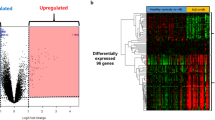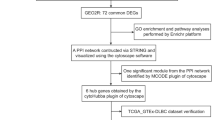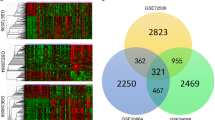Abstract
Systemic lupus erythematosus (SLE) is an autoimmune disease that involves several organ systems. Although B cells play a key role in SLE pathogenesis, the mechanisms behind B cell dysregulation in SLE development remained controversial. Finding the modules containing highly co-expressed genes in B cells could explain biological pathways involved in the pathogenesis of SLE, which may further support the reasons for the altered function of B cells in SLE disease. A total of three microarray gene expression datasets were downloaded from Gene Expression Omnibus. SLE samples were prepared from the purified B lymphocyte cells of the patients who have not received immunosuppressive drugs as well as high dose immunocytotoxic therapies or steroids. A weighted gene co-expression network was then constructed to find the relevant modules implicated in the SLE progression. Among 17 identified modules, 3 modules were selected through mapping to STRING and finding the ones that had highly connection at the protein level. These modules clearly indicate the involvement of several pathways in the pathogenesis of SLE including viral infection, adaptive immune response, and innate immune response in B lymphocytes. The WGCN analysis further revealed the co-expressed genes involved in both innate and adaptive immune systems. Mix infections and primary immunodeficiency might also dysregulate B lymphocytes, which may facilitate SLE development. As such, identifying novel biomarkers and pathways in lupus would be of importance.




Similar content being viewed by others
Data availability
All data generated or analyzed during this study are included in this published article.
References
Jakes RW, Bae SC, Louthrenoo W, Mok CC, Navarra SV, Kwon N. Systematic review of the epidemiology of systemic lupus erythematosus in the Asia-Pacific region: prevalence, incidence, clinical features, and mortality. Arthritis Care Res. 2012;64(2):159–68.
Wakeland EK, Liu K, Graham RR, Behrens TW. Delineating the genetic basis of systemic lupus erythematosus. Immunity. 2001;15(3):397–408. https://doi.org/10.1016/s1074-7613(01)00201-1.
Maidhof W, Hilas O. Lupus: an overview of the disease and management options. Pharm Ther. 2012;37(4):240.
Pan L, Lu M-P, Wang J-H, Xu M, Yang S-R. Immunological pathogenesis and treatment of systemic lupus erythematosus. World J Pediatr. 2020;16(1):19–30.
Shlomchik MJ. Sites and stages of autoreactive B cell activation and regulation. Immunity. 2008;28(1):18–28.
Lund FE. Cytokine-producing B lymphocytes—key regulators of immunity. Curr Opin Immunol. 2008;20(3):332–8.
Hampe CS. B cells in autoimmune diseases. Scientifica. 2012;2012:215308.
Harvey PR, Gordon C. B-cell targeted therapies in systemic lupus erythematosus. BioDrugs. 2013;27(2):85–95.
Sherer Y, Gorstein A, Fritzler MJ, Shoenfeld Y. Autoantibody explosion in systemic lupus erythematosus: more than 100 different antibodies found in SLE patients. Seminars in arthritis and rheumatism. 2004; 34(2):501–37.
Dema B, Charles N. Autoantibodies in SLE: specificities, isotypes and receptors. Antibodies. 2016;5(1):2.
Thurman JM, Yapa R. Complement therapeutics in autoimmune disease. Front Immunol. 2019;10:672.
Yurasov S, Tiller T, Tsuiji M, Velinzon K, Pascual V, Wardemann H, et al. Persistent expression of autoantibodies in SLE patients in remission. J Exp Med. 2006;203(10):2255–61.
Liu R, Zhang W, Liu Z-Q, Zhou H-H. Associating transcriptional modules with colon cancer survival through weighted gene co-expression network analysis. BMC Genomics. 2017;18(1):361. https://doi.org/10.1186/s12864-017-3761-z.
Miller JA, Cai C, Langfelder P, Geschwind DH, Kurian SM, Salomon DR, et al. Strategies for aggregating gene expression data: The collapseRows R function. BMC Bioinformatics. 2011;12(1):322. https://doi.org/10.1186/1471-2105-12-322.
Holtman IR, Raj DD, Miller JA, Schaafsma W, Yin Z, Brouwer N, et al. Induction of a common microglia gene expression signature by aging and neurodegenerative conditions: a co-expression meta-analysis. Acta Neuropathol Commun. 2015;3(1):31.
Langfelder P, Horvath S. WGCNA: an R package for weighted correlation network analysis. BMC Bioinformatics. 2008;9(1):559.
Giulietti M, Occhipinti G, Principato G, Piva F. Weighted gene co-expression network analysis reveals key genes involved in pancreatic ductal adenocarcinoma development. Cell Oncol. 2016;39(4):379–88.
Szklarczyk D, Gable AL, Lyon D, Junge A, Wyder S, Huerta-Cepas J, et al. STRING v11: protein–protein association networks with increased coverage, supporting functional discovery in genome-wide experimental datasets. Nucleic Acids Res. 2018;47(D1):D607–13.
Szklarczyk D, Franceschini A, Wyder S, Forslund K, Heller D, Huerta-Cepas J, et al. STRING v10: protein–protein interaction networks, integrated over the tree of life. Nucleic Acids Res. 2014;43(D1):D447–52.
Bastian M, Heymann S, Jacomy M. Gephi: an open source software for exploring and manipulating networks. Third international AAAI conference on weblogs and social media2009.
Reimand J, Arak T, Adler P, Kolberg L, Reisberg S, Peterson H, et al. g: Profiler—a web server for functional interpretation of gene lists (2016 update). Nucleic Acids Res. 2016;44(W1):W83–9.
Clark MR, Mandal M, Ochiai K, Singh H. Orchestrating B cell lymphopoiesis through interplay of IL-7 receptor and pre-B cell receptor signalling. Nat Rev Immunol. 2014;14(2):69–80. https://doi.org/10.1038/nri3570.
Dorner T, Giesecke C, Lipsky PE. Mechanisms of B cell autoimmunity in SLE. Arthritis Res Ther. 2011;13(5):243. https://doi.org/10.1186/ar3433.
Frances R, Tumang JR, Rothstein TL. B-1 cells are deficient in Lck: defective B cell receptor signal transduction in B-1 cells occurs in the absence of elevated Lck expression. J Immunol. 2005;175(1):27–31. https://doi.org/10.4049/jimmunol.175.1.27.
Poole BD, Templeton AK, Guthridge JM, Brown EJ, Harley JB, James JA. Aberrant Epstein-Barr viral infection in systemic lupus erythematosus. Autoimmun Rev. 2009;8(4):337–42. https://doi.org/10.1016/j.autrev.2008.12.008.
Moon UY, Park SJ, Oh ST, Kim WU, Park SH, Lee SH, et al. Patients with systemic lupus erythematosus have abnormally elevated Epstein-Barr virus load in blood. Arthritis Res Ther. 2004;6(4):R295-302. https://doi.org/10.1186/ar1181.
McChesney MB, Kehrl JH, Valsamakis A, Fauci AS, Oldstone MB. Measles virus infection of B lymphocytes permits cellular activation but blocks progression through the cell cycle. J Virol. 1987;61(11):3441–7.
Zhdanov V. Integration of viral genomes. Nature. 1975;256(5517):471–3.
Viola MV, Gann K, Scott C, Rothfield N. Absence of measles proviral DNA in systemic lupus erythematosus. Nature. 1978;275(5681):667–9. https://doi.org/10.1038/275667a0.
Cunninghame Graham DS. Genome-wide association studies in systemic lupus erythematosus: a perspective. Arthritis Res Ther. 2009;11(4):119. https://doi.org/10.1186/ar2739.
Grammatikos AP, Tsokos GC. Immunodeficiency and autoimmunity: lessons from systemic lupus erythematosus. Trends Mol Med. 2012;18(2):101–8. https://doi.org/10.1016/j.molmed.2011.10.005.
Odendahl M, Jacobi A, Hansen A, Feist E, Hiepe F, Burmester GR, et al. Disturbed peripheral B lymphocyte homeostasis in systemic lupus erythematosus. J Immunol. 2000;165(10):5970–9. https://doi.org/10.4049/jimmunol.165.10.5970.
Chen L, Widhopf G, Huynh L, Rassenti L, Rai KR, Weiss A, et al. Expression of ZAP-70 is associated with increased B-cell receptor signaling in chronic lymphocytic leukemia. Blood. 2002;100(13):4609–14.
Chen L, Apgar J, Huynh L, Dicker F, Giago-McGahan T, Rassenti L, et al. ZAP-70 directly enhances IgM signaling in chronic lymphocytic leukemia. Blood. 2005;105(5):2036–41.
Dörner T, Giesecke C, Lipsky PE. Mechanisms of B cell autoimmunity in SLE. Arthritis Res Ther. 2011;13(5):243. https://doi.org/10.1186/ar3433.
Majolini MB, D’elios MM, Galieni P, Boncristiano M, Lauria F, Del Prete G, et al. Expression of the T-cell–specific tyrosine kinase Lck in normal B-1 cells and in chronic lymphocytic leukemia B cells. Blood. 1998;91(9):3390–6.
Isaák A, Gergely P Jr, Szekeres Z, Prechl J, Poór G, Erdei A, et al. Physiological up-regulation of inhibitory receptors FcγRII and CR1 on memory B cells is lacking in SLE patients. Int Immunol. 2008;20(2):185–92.
Dommett RM, Klein N, Turner MW. Mannose-binding lectin in innate immunity: past, present and future. Tissue Antigens. 2006;68(3):193–209. https://doi.org/10.1111/j.1399-0039.2006.00649.x.
Carroll MC. The role of complement in B cell activation and tolerance. Adv Immunol. 2000;74:61–88. https://doi.org/10.1016/s0065-2776(08)60908-6.
Feng X, Wu H, Grossman JM, Hanvivadhanakul P, FitzGerald JD, Park GS, et al. Association of increased interferon-inducible gene expression with disease activity and lupus nephritis in patients with systemic lupus erythematosus. Arthritis Rheum. 2006;54(9):2951–62. https://doi.org/10.1002/art.22044.
Unterholzner L. The interferon response to intracellular DNA: why so many receptors? Immunobiology. 2013;218(11):1312–21. https://doi.org/10.1016/j.imbio.2013.07.007.
Bentz GL, Shackelford J, Pagano JS. Epstein-Barr virus latent membrane protein 1 regulates the function of interferon regulatory factor 7 by inducing its sumoylation. J Virol. 2012;86(22):12251–61. https://doi.org/10.1128/JVI.01407-12.
Wang JH, Wu Q, Yang P, Li H, Li J, Mountz JD, et al. Type I interferon-dependent CD86(high) marginal zone precursor B cells are potent T cell costimulators in mice. Arthritis Rheum. 2011;63(4):1054–64. https://doi.org/10.1002/art.30231.
Pau E, Cheung YH, Loh C, Lajoie G, Wither JE. TLR tolerance reduces IFN-alpha production despite plasmacytoid dendritic cell expansion and anti-nuclear antibodies in NZB bicongenic mice. PLoS ONE. 2012;7(5):e36761. https://doi.org/10.1371/journal.pone.0036761.
Hamilton JA, Hsu HC, Mountz JD. Role of production of type I interferons by B cells in the mechanisms and pathogenesis of systemic lupus erythematosus. Discov Med. 2018;25(135):21–9.
Applequist SE, Wallin RP, Ljunggren HG. Variable expression of Toll-like receptor in murine innate and adaptive immune cell lines. Int Immunol. 2002;14(9):1065–74. https://doi.org/10.1093/intimm/dxf069.
Kenny EF, Quinn SR, Doyle SL, Vink PM, van Eenennaam H, O’Neill LAJ. Bruton’s tyrosine kinase mediates the synergistic signalling between TLR9 and the B cell receptor by regulating calcium and calmodulin. PLoS ONE. 2013;8(8):e74103. https://doi.org/10.1371/journal.pone.0074103.
Gao W, Xiong Y, Li Q, Yang H. Inhibition of toll-like receptor signaling as a promising therapy for inflammatory diseases: a journey from molecular to nano therapeutics. Front Physiol. 2017;8(508). https://doi.org/10.3389/fphys.2017.00508.
Ziegler-Heitbrock HW, Pechumer H, Petersmann I, Durieux JJ, Vita N, Labeta MO, et al. CD14 is expressed and functional in human B cells. Eur J Immunol. 1994;24(8):1937–40. https://doi.org/10.1002/eji.1830240835.
Duhlin A. The regulation of B cell responses in systemic autoimmunity. Thesis, 2017
McGaha TL, Sorrentino B, Ravetch JV. Restoration of tolerance in lupus by targeted inhibitory receptor expression. Science. 2005;307(5709):590–3.
Kyogoku C, Dijstelbloem HM, Tsuchiya N, Hatta Y, Kato H, Yamaguchi A, et al. Fcγ receptor gene polymorphisms in Japanese patients with systemic lupus erythematosus: contribution of FCGR2B to genetic susceptibility. Arthritis Rheum. 2002;46(5):1242–54.
Mkaddem SB, Murua A, Flament H, Titeca-Beauport D, Bounaix C, Danelli L, et al. Lyn and Fyn function as molecular switches that control immunoreceptors to direct homeostasis or inflammation. Nat Commun. 2017;8(1):1–13.
Ben Mkaddem S, Benhamou M, Monteiro RC. Understanding Fc receptor involvement in inflammatory diseases: from mechanisms to new therapeutic tools. Front Immunol. 2019;10(811). https://doi.org/10.3389/fimmu.2019.00811.
Hayden MS, West AP, Ghosh S. NF-kappaB and the immune response. Oncogene. 2006;25(51):6758–80. https://doi.org/10.1038/sj.onc.1209943.
Schulze-Luehrmann J, Ghosh S. Antigen-receptor signaling to nuclear factor kappa B. Immunity. 2006;25(5):701–15. https://doi.org/10.1016/j.immuni.2006.10.010.
Martin P, Moscat J. Th1/Th2 differentiation and B cell function by the atypical PKCs and their regulators. Front Immunol. 2012;3(241). https://doi.org/10.3389/fimmu.2012.00241.
Yu S-L, Kuan W-P, Wong C-K, Li EK, Tam L-S. Immunopathological roles of cytokines, chemokines, signaling molecules, and pattern-recognition receptors in systemic lupus erythematosus. Clin Dev Immunol. 2012;2012:715190. https://doi.org/10.1155/2012/715190.
Hampe CS. B cells in autoimmune diseases. Scientifica. 2012;2012:215308. https://doi.org/10.6064/2012/215308.
Liu Q, Liu Z, Rozo CT, Hamed HA, Alem F, Urban JF Jr, et al. The role of B cells in the development of CD4 effector T cells during a polarized Th2 immune response. J Immunol. 2007;179(6):3821–30. https://doi.org/10.4049/jimmunol.179.6.3821.
Choi SC, Morel L. B cell contribution of the CD4(+) T cell inflammatory phenotypes in systemic lupus erythematosus. Autoimmunity. 2017;50(1):37–41. https://doi.org/10.1080/08916934.2017.1280028.
Harvey BP, Gee RJ, Haberman AM, Shlomchik MJ, Mamula MJ. Antigen presentation and transfer between B cells and macrophages. Eur J Immunol. 2007;37(7):1739–51.
Funding
This study was supported by the Tehran University of Medical Sciences (Grant No: 96–01-27–32013).
Author information
Authors and Affiliations
Corresponding author
Ethics declarations
Ethics approval and consent to participate
Not applicable.
Conflict of interest
The authors declare that they have no conflict of interest.
Additional information
Publisher’s note
Springer Nature remains neutral with regard to jurisdictional claims in published maps and institutional affiliations.
Rights and permissions
About this article
Cite this article
Ghobadi, M.Z., Izadi, S., Teymoori-Rad, M. et al. Potential role of viral infection and B cells as a linker between innate and adaptive immune response in systemic lupus erythematosus . Immunol Res 69, 196–204 (2021). https://doi.org/10.1007/s12026-021-09186-4
Received:
Accepted:
Published:
Issue Date:
DOI: https://doi.org/10.1007/s12026-021-09186-4




